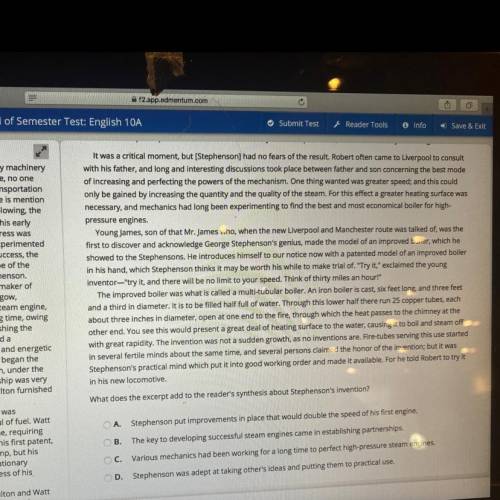
English, 11.08.2021 04:00 dreamdancekay
The Steam Engine
The idea of using steam for driving stationary machinery originated in the early centuries. For a long time, no one seemed to have thought of using steam for transportation
purposes. In the earlier historical records, there is mention of "heat engines," which were used for organ blowing the turning of spits!, and like purposes. But from this early date
until the 17th century, practically no progress was made in the use of steam. Though men had experimented with steam up to this time with more or less success, the world is
chiefly indebted for the developed type of the steam engine to James Watt and George Stephenson.
James Watt, who secured the position as a maker of scientific instruments in the University of Glasgow, proposed an idea for improving the existing steam engine, which was
used for pumping mines. For a long time, owing to a lack of money, he had difficulty in establishing the merits of his improvements. Finall e formed a partnership with Matthew
Boulton, a wealthy and energetic man who lived at Birmingham, England. They began the manufacture of steam engines at Birmingham, under the firm name of Boulton and Watt.
This partnership was very successful. Watt supplied the inventions; Boulton furnished the money and attended to the business.
Before the time of Watt, the steam engine was exclusively a steam pump-slow and wasteful of fuel. Watt made it a quick, powerful, and efficient engine, requiring only a fourth
as much fuel as before. Under his first patent, the engine was still used only as a steam pump, but his later improvements adapted it for driving stationary machinery of all kinds.
The commercial success of his engine was soon fully established.
George Stephenson further modified Boulton and Watt Company's creation. Stephenson initiated the use of steam for carrying passengers and goods. In September 1825, the
first train passed over the road. It consisted of thirty-four cars weighing, all told, ninety tons. The train was pulled by Stephenson's engine, operated by Stephenson himself, with a
signalman riding on horseback in advance. The train moved off at the rate of ten or twelve miles an hour, and on certain parts of the road it reached a speed of fifteen miles per
hour. The trial was a complete success.
ne butir
1. a rotatable machine that is used to cook meat


Answers: 2


Another question on English

English, 21.06.2019 22:30
1) earth's crust is made up of relatively rigid plates that ride atop earth's hot, semiliquid mantle. (2) the plates are called tectonic because they're in constant motion. (3) they can move because earth's mantle is a very hot and semiliquid fluid called magma. (4) volcanoes are a result of magma rising up or erupting through a plate, particularly where plate boundaries are moving against each other. (5) also, when plates slide against each other, causing friction along adjacent plate boundaries, earthquakes frequently occur. (6) therefore, we often find volcanoes and earthquakes along plate boundaries. (7) plates may also collide. (8) when that happens, mountain ranges are formed. (9) for example, the collision of the plate carrying the indian subcontinent created the himalayan mountains when it collided with the asian plate. which statement about this paragraph is accurate?
Answers: 3

English, 21.06.2019 23:30
Ineed ideas for this essay something easy that i can do does anyone have any ideas on what i should write on for this 100 points ! write a procedural essay with media that is 1 ½–2 pages in length. clearly state your topic, and include all steps necessary to complete the procedure. you will submit your prewriting and planning documents along with your essay.
Answers: 2

English, 22.06.2019 07:00
In a 10-12 sentence response-style paragraph, explore the degree to which you agree or disagree with faulkner’s message. “i believe that man will not merely endure: he will prevail. he is immortal, not because he alone among creatures has an inexhaustible voice, but because he has a soul, a spirit capable of compassion and sacrifice and endurance. the poet's, the writer's, duty is to write about these things. it is his privilege to man endure by lifting his heart, by reminding him of the courage and honor and hope and pride and compassion and pity and sacrifice which have been the glory of his past. the poet's voice need not merely be the record of man, it can be one of the props, the pillars to him endure and prevail” (faulkner 773-775).
Answers: 2

English, 22.06.2019 09:00
Drag each tile to the correct box. arrange the steps involved in close reading sequentially, from what you would do first to what you would do last.
Answers: 1
You know the right answer?
The Steam Engine
The idea of using steam for driving stationary machinery originated in the early c...
Questions






















